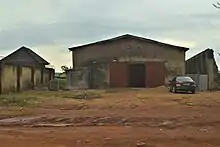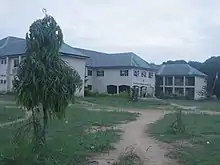Southern Kaduna
Southern Kaduna (Tyap: A̱tak Ka̱duna; Hausa: Kudancin Kaduna; formerly Southern Zaria)[1] is an area inhabited by primarily various non-Hausa speaking peoples living in the south of Zazzau Emirate of Kaduna State. It is located in the Middle Belt region of Nigeria. Southern Kaduna consists of 12 Local Government Areas out of a total of 23 in Kaduna State. Some view it as being less of a geographical identity and more of an ethnic identity concept.[2]
Southern Kaduna
Gurara/Nok Southern Zaria | |
|---|---|
Cultural region | |
| Nickname: Chongai S/K | |
| Part of | Kaduna State |
| - Settlement of Nok culture | c. 1500 BC |
| - Nok culture area | c. 1500 BC - c. 500 AD |
| - Kwararafa confederacy | c. 900 - c. 1700 |
| - Northern Region British Nigeria (later Middle Belt, Nigeria) | 1903-4 (1950s) |
| - Southern Zaria | c. 1900 |
| - Nerzit region | c. 1950 |
| - Southern Kaduna | c. 1990 |
| - Gurara/Nok State | proposed |
| Founded by | - Proto Nok people |
| Capital | • Kafanchan (Economic capital) |
| Composed of | |
| Government | |
| • Type | Chief • Agwam, Agwom (Agom), B'gwam, Ere, Esu (Sa), Etum, Kpop, Ngbiar, Odyong, Pukgom, Res, Tum, Uchu • Clan heads • Village heads |
| Population (2016 estimate) | |
| • Total | 4,564,100 |
| Demographics | |
| • Major languages | |
| Time zone | WAT |
Subdivisions
Ethnic composition
Southern Kaduna is composed of closely related ethnic groups and several subgroups united by a common culture and history. James (2000) classified these people based on their ethno-linguistic affinities under the topic "The Middle Belt (Composition of the Nok Culture Area)", and grouping the subgroups into the following groups:[3] the Southern kaduna population is estimated to be over 4.5 million people out of the estimated 8.5 million population in Kaduna state in 2016. Predicted 5.1 million people out of 12 million predicted population of Kaduna State in 2021. The common general language speaking in the area is Hausa Language as medium of communication.[4]
The Proto-Plateau ethnolinguistic cluster
I. Northern or Adara Group
- Adara (Kadara)
- Ada (Kuturmi)
- Ajure Adara (Kadara of Idon)
- Anumafa Adara (Kadara Kateri)
- Semi Ajure (Ankuwa, Gora)
- Bakulu (Ikulu)
II. Western or Koro Group
- Koro Myamya
- Koro Achel, Ashe or Wachi
- Koro Ala or Agweshi
- Koro Ham or Adong/Gbaham
III. Ham or Northwestern Group
- Ham Kpop (Jaba Kwoi)
- Ham Ngat Ham (Jaban Katari)
- Ham Shambang (Samban)
- Ham Duhyah (Jaban Lungu)
- Ham Gwong (Kagoma)
- Ham Kworri (Chori)
- Ham Det (Faik/Kenyi)
- Ham Netkun/Netwho - Gbaham
- Ham Nyakpah (Yeskwa)
- Ham Kong/Rhuini (Kamantan)
IV. Nerzit or Kataf (Atyap) Group
- Atyap (Kataf, Katab)
- Bajju (Kaje)
- Agworok (Aegworok, Oegworok, Kagoro)
- Asholyio (Osholio, Asholio, Moro'a)
- Fantswam (Kafanchan)
- Bakulu (Ikulu)
- Anghan (Angan, Kamantan)
- Atakad (Atakat, Attakar)
- Atyecharak (Atyacherak, Attachirak, Kachechere)
- Terri (Challa, Chara)
- Atuku (tuku) Kuu""
V. South-western (Aninka) Group
- Ninzo
- Northern Mada
- Gbantu (Gwantu)
- Nindem
- Nikyob (Kaninkon)
- Kanufi
- Nungu
- Buh - Ayu
- Ningeshe
- Nandu
- Numana
The above grouping on the Proto-Plateau ethnolinguistic clusters was however modified based on the spoken languages by Blench (2008) as follows:[5]
I. Northwest or Adara Group
- Eda, Ada
- Edra, Adara
- Bakulu
- Ẹjẹgha (Idon)
- Doka
- Ẹhwa (Iku-Gora-Ankwe)
II. Atyap (Nerzit, Nenzit) Group
- Bajju
- Atyap
- Agworok (Kagoro)
- Takad (Attakar)
- Atyecarak (Kacicere)
- Asholyio
- Fantswam (Kafancan)
- Atuku (Tuku) Kuu
III. Koro Group
- Ashe
- Tinɔr (Waci-Myamya)
- Idũ, Gwara
- Nyenkpa-Barde
IV. Ham Group
- Shamang
- Cori
- Ham
- Zhire
- Shang
V. Gwong Group
VI. Ninzo Group
- Ninzo (Ninzam)
- Bu-Niŋkada
- Mada
- Numana-Nunku-Gbantu-Numbu
- Ningye-Ninka
- Anib
- Nikyob
- Nindem
- Nungu
- Ayu
VII. Ndun Group
- Ndun (Nandu)
VIII. Alumu Group
The Proto-Kainji ethnolinguistic cluster
I. Eastern Kainji Group I
- Atsam (Chawai)
- Amap (Amo)
- Abisi (Piti)
- Kuzamani (Shuwa-Zamani)
- Ngmgbang (Ribam)
- Dinani (Dingi)
- Ribina
II. Eastern Kainji Group II
- Agbiri (Gure)
- Aniragu (Kahugu)
- Akurmi (Kurama)
- Koonu (Kono)
- Vono (Kiballo)
- Tumi (Kitimi)
- Nuno-Kaivi (Kaibi)
- Mala-Ruma (Rumaya/Ruruma)
- Abin (Binawa)
- Kuvori (Surubu)
- Atumu (Kinuku)
- Shuwa-Zamani (Kuzamani)
- Dungi (Dungu)
Languages
Southern Kaduna consists of a diverse minority of ethnolinguistic groups, who speak languages belonging to the Niger–Congo and West Chadic language groups.[8] Below are the languages and dialects spoken by the people of Southern Kaduna:
| LGA | Languages |
|---|---|
| Chikun | Gbagyi |
| Jaba | Ashe; Duya; Hyam |
| Jema'a | Ashe; Berom; Duya; Fantswam; Gyong; Hyam; Jju; Kanufi; Mada; Kyoli Nikyob-Nindem; Ninzo; Nungu; Nyankpa; Shamang; Tyap; Tyuku Zhire; Numana |
| Kachia | Adara; Doka; Gbagyi; Hyam; Iku-Gora-Ankwa; Ikulu; Jju; Nghan; Koro Wachi; Ada; Shamang; Tyap; Zhire |
| Kaduna South | Adara; Gbagyi; Hausa; Idoma; Igbo; Tyap; Yoruba |
| Kagarko | Ashe; Duya; Gbagyi; Koro Wachi |
| Kajuru | Adara; Ajiya; Gbagyi; Kuzamani |
| Kaura | Gworok; Firan; Iten; Takad; Sholyio; Tyap and Tyecarak (Tyecaat) |
| Kauru | Bisi; Bina; Dungu; Ikulu; Kaivi; Kinuku; Koonu; Mala; Mbang; Rigwe; Ruma; Sheni; T'kurmi; Tsam; Tumi; Tyap; Vono; Tuvori and Hausa |
| Lere | T'kurmi, Timap; Bina; Lere; Tugbiri-Niragu and Hausa |
| Sanga | Ahwai; Ayu; Bu; Gwandara; Hasha; Ninzo; Numana; Nungu; Sambe; Sha; Toro |
| Zangon Kataf | Ikulu; Jju; Nghan; and Tyap; Tyecarak (Tyecaat) |
Natural resources
Former Nigerian Minister of Solid Minerals, Leslie Obiora, compiled a list of minerals across the country, which amounted to a total of 74 minerals; 34 were declared fit for mining on a commercial scale, with Southern Kaduna having over 30 minerals with over fifty percent (50%) of them minable.[10]
Agriculture

In the 1990s, ginger farmers enjoyed profit from the sales of their harvested crops due to the availability of ginger processing companies all over the region, but today, most of those companies have shut down without efforts to revive them on the side of the government.[11]
Education

It was asserted by Kazah-Toure (1999:130) that Southern Kaduna took a lead in education in the defunct Northern Region, during the period around the Nigerian Civil War (between 1966 and 1970s).[12] Bonat (1989:55) claims that a majority of the educated people from this region who are non-Hausa, were in the teaching profession and in the middle cadre of the civil service in contrast to the Hausa who were dominant at the highest bureaucratic levels.[13]
Present tertiary institutions
- Air Force Institute of Technology (Nigeria), Kaduna
- Greenfield University, Kaduna
- Kaduna Polytechnic, Kaduna
- Kaduna State University, Kaduna and Kafanchan Campuses
- National Open University of Nigeria, Gworok Study Center
- Nigerian Defence Academy (NDA), Kaduna
- Kaduna State College of Education, Kafanchan
- School of Agricultural Technology, Nuhu Bamalli Polytechnic, Cenkwon
- College of Nursing, Kafanchan
Notable people
See also
References
- Kafewo, S. (2009). "Giving Voice: Instigating Debate on Issues of Citizenship, Participation, and Accountability". Development in Practice. 19 (4/5): 678–687. doi:10.1080/09614520902866454. JSTOR 27752105. S2CID 37550776. Retrieved 1 January 2021.
- Angerbrandt, Henrik (7 August 2015). "Religion, ethnicity and citizenship: demands for territorial self-determination in southern Kaduna". Journal of Contemporary African Studies. 33 (2). doi:10.1080/02589001.2015.1066081. S2CID 154843125. Retrieved 15 July 2020.
- James, Ibrahim (2000). The Settler Phenomenon in the Middle Belt and the Problem of National Integration in Nigeria: The Middle Belt (Ethnic Composition of the Nok Culture).
- James, Ibrahim (2007). The politics of creation of chiefdoms in Kaduna state. Vanguard Publishers Ltd.
- Blench, Roger M. 2018. Nominal affixes and number marking in the Plateau languages of Central Nigeria. In John R. Watters (ed.), East Benue-Congo: Nouns, pronouns, and verbs, 107–172. Berlin: Language Science Press. doi:10.5281/zenodo.1314325
- Blench, Roger M. 2012. Akpondu, Nigbo, Bəbər and Nisam: moribund or extinct languages of central Nigeria Babur.
- "Ethnologue entry on Gwandara". Retrieved 18 August 2020.
- "Languages of Africa". www.fmprc.gov.cn. Retrieved 30 May 2020.
- "Nigeria". Ethnologue (22 ed.). Retrieved 10 January 2020.
- Haruna, David Livingstone (20 February 2020). "Nigeria: Southern Kaduna and Tale of Illegal Artisans, Miners". All Africa. Retrieved 14 July 2020.
- Isuwa, Sunday (16 December 2013). "The Lost Glory of Ginger in Southern Kaduna". Daily Trust (Abuja). Retrieved 29 August 2020.
- Kazah-Toure, T. (1999). "The Political Economy of Ethnic Conflicts and Governance in Southern Kaduna, Nigeria: [De]Constructing a Contested Terrain". Africa Development / Afrique et Développement. 24 (1/2): 109–144. JSTOR 24484540. Retrieved 14 January 2021.
- Bonat, Z. A. (1989). "Aspects of the Economic and Social History of the Atyab c. 1800-1960 A.D.". Savanna. Zaria: ABU Press. 10 (1): 55.
External links
![]() Media related to Southern Kaduna at Wikimedia Commons
Media related to Southern Kaduna at Wikimedia Commons